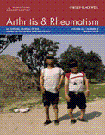Two-year clinical and radiographic results with combination etanercept–methotrexate therapy versus monotherapy in early rheumatoid arthritis: A two-year, double-blind, randomized study†
ClinicalTrials.gov identifier: NCT00195494.
Dr. Emery is an Arthritis Research Campaign Professor of Rheumatology.
Dr. Emery has received consulting fees, speaking fees, and/or honoraria from Wyeth Pharmaceuticals (less than $10,000) and research grants from Wyeth Pharmaceuticals, and was the primary investigator in this trial.
Abstract
Objective
To evaluate how continuation of and alterations to initial year 1 combination etanercept–methotrexate (MTX) therapy and MTX monotherapy regimens affect long-term remission and radiographic progression in early, active rheumatoid arthritis.
Methods
Subjects were randomized at baseline for the entire 2-year period; those who completed 1 year of treatment with combination or MTX monotherapy entered year 2. The original combination group either continued combination therapy (the EM/EM group; n = 111) or received etanercept monotherapy (the EM/E group; n = 111) in year 2; the original MTX monotherapy group either received combination therapy (the M/EM group; n = 90) or continued monotherapy (the M/M group; n = 99) in year 2. Efficacy end points included remission (a Disease Activity Score in 28 joints [DAS28] <2.6) and radiographic nonprogression (change in the modified Sharp/van der Heijde score ≤0.5) at year 2. A last observation carried forward analysis from the modified intention-to-treat population (n = 398) and a post hoc nonresponder imputation (NRI) analysis (n = 528) were performed for remission.
Results
At year 2, DAS28 remission was achieved by 62/108, 54/108, 51/88, and 33/94 subjects in the EM/EM, EM/E, M/EM, and M/M groups, respectively (P < 0.01 for the EM/EM and M/EM groups versus the M/M group). This effect was corroborated by a more conservative post hoc 2-year NRI analysis, with remission observed in 59/131, 50/134, 48/133, and 29/130 of the same respective groups (P < 0.05 for each of the EM/EM, EM/E, and M/EM groups versus the M/M group). The proportions of subjects achieving radiographic nonprogression (n = 360) were 89/99, 74/99, 59/79, and 56/83 in the EM/EM (P < 0.01 versus each of the other groups), EM/E, M/EM, and M/M groups, respectively. No new safety signals or between-group differences in serious adverse events were seen.
Conclusion
Early sustained combination etanercept–MTX therapy was consistently superior to MTX monotherapy. Combination therapy resulted in important clinical and radiographic benefits over 2 study years, without significant additional safety risk.




